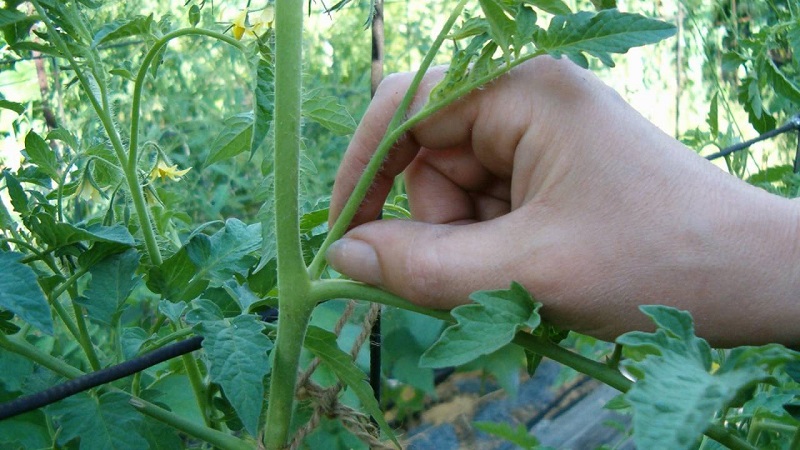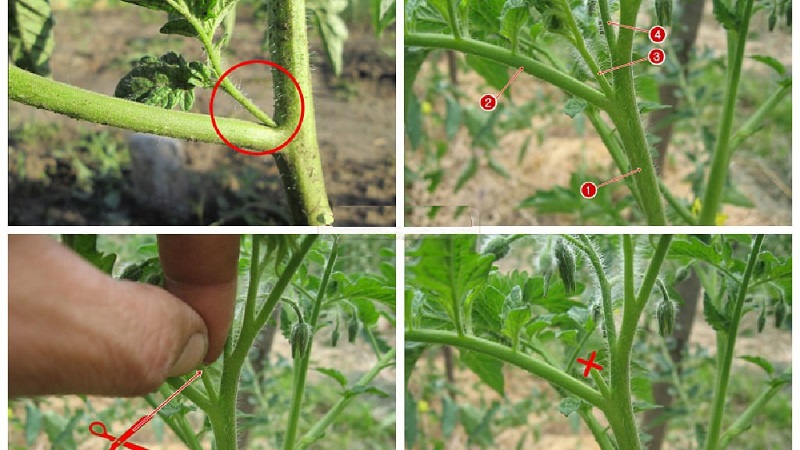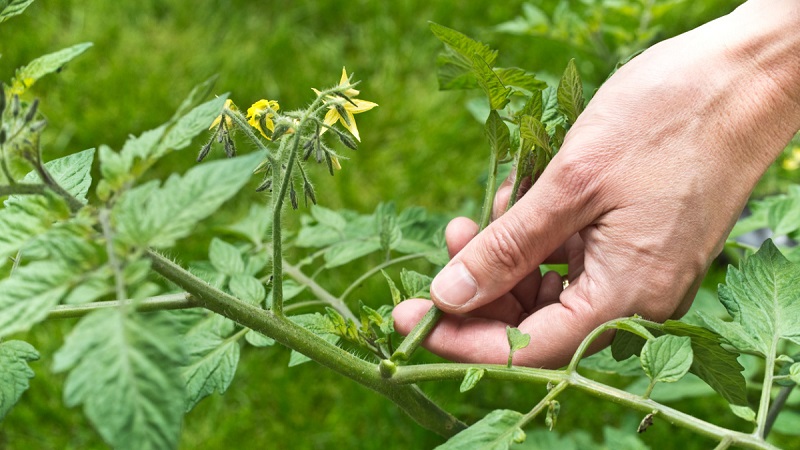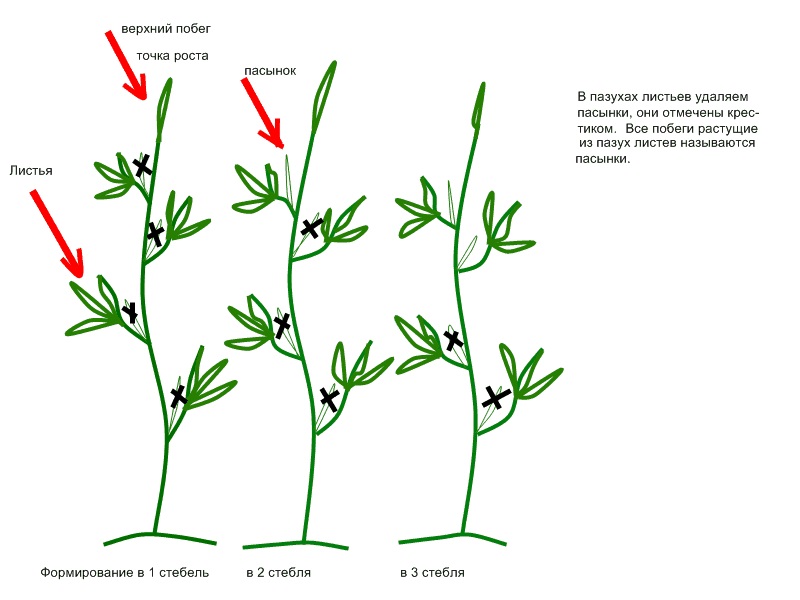Step-by-step instructions for novice gardeners: how to correctly pinch tomatoes in a greenhouse and why you need it
To increase the yield of tomatoes, you need to properly form the bushes. So the plant will direct its forces to laying and ripening fruits. The main technique is pinching. Consider how to correctly pinch tomatoes in a greenhouse and analyze common mistakes.
The content of the article
What is pinning and what is it for?
Pickling and pinching - the formation of tomato bushes by removing unnecessary lateral processes, the so-called stepsons, and the tops. This technique increases yields, accelerates the ripening of fruits, and facilitates care.
When and how often
The first pinching is carried out at the beginning of the formation of the first inflorescence. Tomatoes should be inspected regularly and excess shoots removed when they have not yet grown more than 5 cm in length.
Greenhouse tomatoes stepchildren once every 6-7 days, ground children - once every 10-14 days. It is necessary to remove unnecessary shoots constantly, even after the start of fruit ripening.
It is recommended to spend time at the morning hours.

What are stepchildren of tomatoes
The stepson is a new shoot that the tomato throws out from the leaf axils. You can distinguish a stepson from a fruit brush by the following features:
- the stepson grows from the leaf axils, the flower raceme branches off from the stem;
- even a small stepson has leaves, a flower cluster has no leaves.
If, due to lack of experience, doubts arise, the lateral process is left for a day, after which the difference will become more obvious.
General rules
So that pinching does not harm the tomatoes, you need to adhere to simple rules:
- Extra branches are torn off, broken off or pinch, but in no case cut off.
- The event is held in the morning. In the first half of the day, the growing season is more active, and the wounds obtained when removing shoots will heal faster.
- When breaking or breaking off branches, watch out so that the juice does not get on your hands. This will help prevent the spread of diseases, if any, to other bushes.
- Do not allow stepchildren to grow more than 5 cm in length. Removing large shoots is a big stress for plants.
- No more than three stepsons are removed from one bush at a time. If there are many processes, pinching is carried out for 5-6 days, first removing large processes, then moving on to smaller ones.
- Leave a scion about 1-2 cm long when separating the stepson from the bush. This prevents the growth of new shoots in the same place.
- The removed processes are removed from the site. Rotting plant residues can be a source of disease.

Features of the formation of different varieties of tomatoes
All varieties of tomatoes can be divided according to the characteristics of the growth of the bush into groups: indeterminate, determinant, semi-determinant. The approach to formation for each group of varieties is different.
Semi-determinant
Semi-determinant tomatoes (half-dead) grow up to 1.5 m in height. Such plants form in two stems: the strongest stepson is left over the first flower cluster.
As it grows, 2-3 fruit brushes are left on such a lateral stem, on the main one - 3-4 brushes.
Indeterminate
The peculiarity of indeterminate tomatoes (indetes) is unlimited growth of the stem in height, the length of the stem can reach 2-4 m. When the required height is reached, the growth point at the top of the bush is pinched.
The Indet grazing is a mandatory measure, otherwise the bushes will quickly grow to the detriment of fruiting. Form them into one stem.

Determinant
Determinant tomatoes (babies) stop growing in height with the appearance of an inflorescence at the top of the stem. The harvest of such a bush is limited to previously formed clusters.
To increase the number of fruits, a 2-3 stem formation scheme is used. Leave 1-2 of the most powerful stepsons, usually they are located under the first inflorescence.
The subtleties of forming tomatoes in a greenhouse
The peculiarities of the formation of tomato bushes in greenhouses stem from the limited size of the space.
For a more complete use of the greenhouse space, they are mainly grown indeterminate varieties. A single-stem formation scheme is used and always tied up, otherwise the trunk will not withstand the severity of the fruit.
To obtain bountiful harvests in the greenhouse with determinant their bushes are formed into 2-3 stems, leaving shoots under the first and second flower brushes.
Non-sprinkling tomato varieties for cultivation in the greenhouse
Nonsynky varieties are characterized by a low, up to 70 cm, bush, the absence or very small number of stepsons. They are resistant to diseases, tolerate changes in temperature and humidity well.
All unsaturated tomatoes are early or ultra-early, therefore, growing these varieties in a greenhouse, you can get a bountiful harvest by mid-July. The fruits are even, weighing 80-100 g.
Here are some varieties that are suitable for growing in a greenhouse:
- Dubok - ultra early, round fruits with fleshy pulp, weighing 50-100 g;
- Siberian pirouette - gives an elongated tomato shape, which are very good for canning;
- Countryman - high-yielding early variety; the peculiarity of the variety is that it can be grown without seedlings - planting seeds immediately in the greenhouse soil.

What is the procedure
Shrub formation is the regulation of leaf and stem growth. To direct the forces of the plant to the generation of fruits, it is recommended to leave no more than three stems and eight flower brushes on one plant.
Council. To obtain an earlier harvest, no more than three bunches of fruit are left on the bushes and the top is pinched. In this case, fruit ripening begins, and growth stops.
Formation of tomato bushes in a greenhouse: stages of work
The formation of tomato bushes consists of several stages:
- Stealing - removal of excess shoots, limiting the growth of green mass and allowing them to retain the selected shape in one, two or three stems.
- Pinching the top, which stops the growth of the bush and directs the forces of the plant to ripen the fruits.
- Pruning lower wilting leaves after fruit formation to protect against fungal diseases.
The first pinching is carried out 2-2.5 weeks after transplanting. You should adhere to the general rules of pinching:
- Inspect the tomato bushes and outline all stepsons for removal to form into one stem. With a two-stem scheme, leave one of the most powerful shoots under the first brush; from the second stem, the shoots must be removed according to the same rules as on the main one.
- The stepsons are removed by gently breaking them off the bush. So that the branches do not grow back in the same place, they leave a small process 1-2 cm long.
- All removed processes are collected in a container and taken out of the greenhouse.
Step-by-step repetition of stepping is repeated once every 6-7 days.
Pinching instructions
The top of the tomatoes is pinched in late July - early August, when the required number of inflorescences has formed on the bush.
Gently pinch off the stem over the last appeared inflorescence, leaving 1-2 leaves on top. Tall varieties are pinched all season.
We form into one stem
Three patterns of formation are common: one, two and three stems.
When dosing on one stem, all shoots are removed, leaving one stem. The bush develops rapidly, large fruits are formed. In this case, it is imperative to tie up the plants, otherwise the stem will break under the weight of the crop.
Formation of a bush into two or more stems
When formed into two stems, the main stem and one most viable stepson are left, which is located immediately under the first brush.
The three-stem scheme provides for the preservation of two stepsons in addition to the main stem. Two strong shoots are left below the first bunch. This scheme is extremely rarely used in greenhouses.
Common mistakes when pinning
What not to do when pinching so as not to harm the plants:
- Stepson is rare and irregular. This requires a lot of restoration costs from the plants. In addition, the time and nutrients have already been spent growing the foliage rather than the ovary.
- Remove fruit shoots instead of stepsons. If the shoot goes directly from the stem, and inflorescences are formed on it, then this is a fruitful branch.
- Use dirty garden tools. Before pinching and after processing each bush, they must be disinfected, for example, with a 1% solution of potassium permanganate or bleach. Therefore, experienced gardeners pick off excess shoots by hand - this is faster and more efficient.
- Carry out pinching in the evening or in cloudy damp weather. At this time, the vegetation slows down. The wounds obtained when the processes are removed will heal longer, the risk of contracting diseases will increase.

Conclusion
Grasshopping helps direct nutrients to the formation of inflorescences and fruits, shortens ripening times, reduces the risk of infections and facilitates plant care. Caring vegetable growers regularly remove stepchildren no more than 5 cm long, maintaining the chosen shape of the bushes. And tomatoes delight with an abundance of large sweet fruits.
